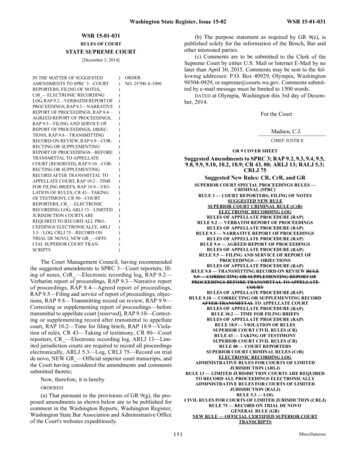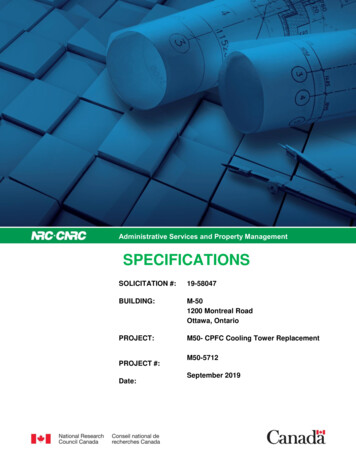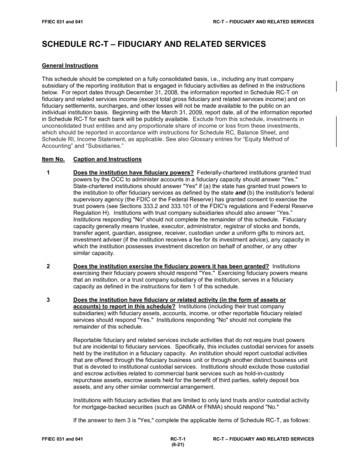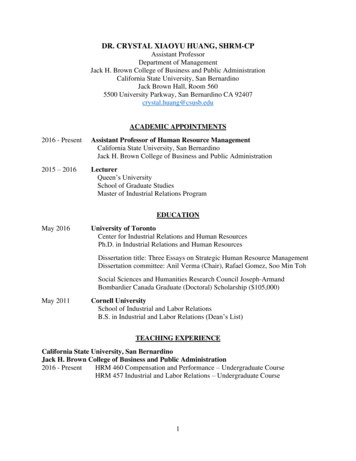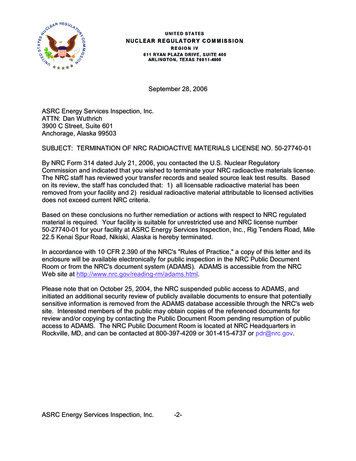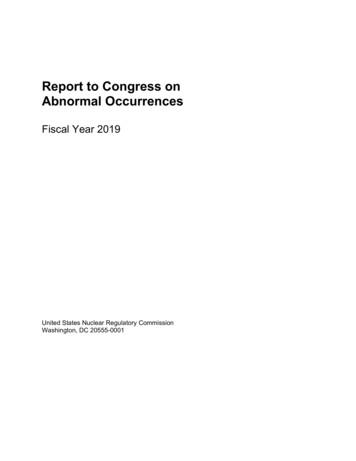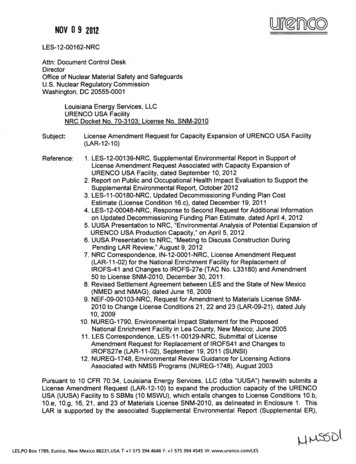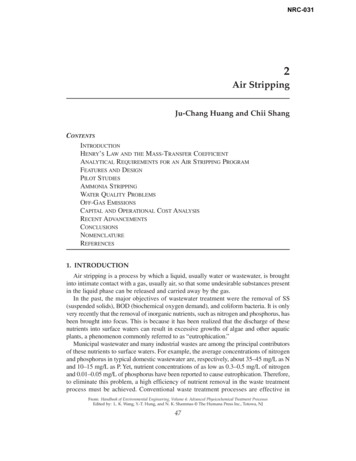
Transcription
NRC-0312Air StrippingJu-Chang Huang and Chii ShangCONTENTSINTRODUCTIONHENRY’S LAW AND THE MASS-TRANSFER COEFFICIENTANALYTICAL REQUIREMENTS FOR AN AIR STRIPPING PROGRAMFEATURES AND DESIGNPILOT STUDIESAMMONIA STRIPPINGWATER QUALITY PROBLEMSOFF-GAS EMISSIONSCAPITAL AND OPERATIONAL COST ANALYSISRECENT ADVANCEMENTSCONCLUSIONSNOMENCLATUREREFERENCES1. INTRODUCTIONAir stripping is a process by which a liquid, usually water or wastewater, is broughtinto intimate contact with a gas, usually air, so that some undesirable substances presentin the liquid phase can be released and carried away by the gas.In the past, the major objectives of wastewater treatment were the removal of SS(suspended solids), BOD (biochemical oxygen demand), and coliform bacteria. It is onlyvery recently that the removal of inorganic nutrients, such as nitrogen and phosphorus, hasbeen brought into focus. This is because it has been realized that the discharge of thesenutrients into surface waters can result in excessive growths of algae and other aquaticplants, a phenomenon commonly referred to as “eutrophication.”Municipal wastewater and many industrial wastes are among the principal contributorsof these nutrients to surface waters. For example, the average concentrations of nitrogenand phosphorus in typical domestic wastewater are, respectively, about 35–45 mg/L as Nand 10–15 mg/L as P. Yet, nutrient concentrations of as low as 0.3–0.5 mg/L of nitrogenand 0.01–0.05 mg/L of phosphorus have been reported to cause eutrophication. Therefore,to eliminate this problem, a high efficiency of nutrient removal in the waste treatmentprocess must be achieved. Conventional waste treatment processes are effective inFrom: Handbook of Environmental Engineering, Volume 4: Advanced Physicochemical Treatment ProcessesEdited by: L. K. Wang, Y.-T. Hung, and N. K. Shammas The Humana Press Inc., Totowa, NJ47
48Huang and Shangremoving only about 40–50% of the nitrogen and 25–30% of the phosphorus. Therefore,new treatment technologies must supplement conventional methods in order to improvethe nutrient removal efficiencies.In typical domestic wastewater, ammonia nitrogen represents about 55–60%, organicnitrogen about 40–45%, and nitrates plus nitrites together about 0–5% of the total nitrogen. Within a waste treatment plant, organic nitrogen is easily converted into ammoniaspecies through hydrolysis, which can take place in various treatment units. A portionof ammonia is then utilized by bacteria for cell synthesis, and the remaining ammoniausually leaks out in the final plant effluent as residual ammonia nitrogen. In some situations, active biological nitrification may take place in the aeration tank. In such a case,most of the excess ammonia will be converted to nitrates.The discovery of chlorinated hydrocarbons in remote global environments promptedresearchers to re-examine the rates of evaporation of these compounds. These compounds,usually of high-molecular-weight and low vapor pressure, exhibit unexpectedly high evaporation rates due to their high equilibrium vapor partial pressures (1,2).The presence of organic compounds that are potentially hazardous or toxic in waterbodies is made increasingly evident by advances in analytical methods. This has resultedin the development of new technologies for the removal of these compounds from rawpotable surface and groundwater supplies, as well as from process stream wastewaterand effluent from groundwater remedial activities.The removal of substances having reasonable equilibrium vapor pressures at ambienttemperatures, including ammonia, carbon dioxide, hydrogen sulfide, and many VOCs(volatile organic compounds), by any of the processes known as air or gas stripping hasproven to be efficient and cost effective. The Henry’s law constant is a primary indicatorof a compound’s potential for removal by air stripping.The countercurrent packed-tower type air stripper offers greater interfacial surfacearea for mass transfer of volatile compounds than do other gas-stripping processes. Thismethod therefore offers significant advantages in efficiency and overall cost when usedfor the removal of volatile compounds from potable or wastewater streams. Equationshave been developed to optimize system design for removal of specific compounds. Inaddition, a pilot study, scaled appropriately to the magnitude and sensitivity of theremoval requirements of the air-stripping project, is recommended to enable the correctdesign specifications and overall cost estimates to be prepared. Secondary factors mayaffect the cost-effectiveness and removal efficiency of air-stripping processes, and therefore will require consideration. Cost modeling and system design to minimize powerrequirements should also be included in the design process.2. HENRY’S LAW AND THE MASS-TRANSFER COEFFICIENTSuch processes as mechanical surface aeration, diffused aeration, spray fountains,spray or tray towers, open-channel cascades, and countercurrent packed towers areencompassed by the term air stripping. These procedures produce a condition in whicha large surface area of the water to be treated is exposed to air, which promotes transferof the contaminant from the liquid phase to the gaseous phase. This occurs becauseunder normal conditions the concentration of the contaminant in ambient air is muchlower than the concentration in contaminated water.
Air Stripping49The ratio of the contaminant at equilibrium in the liquid phase, CL, to the contaminant in the gaseous phase, CG, is a relationship known as Henry’s law:CGCLHc(1)where Hc is Henry’s constant. Henry’s constant is a property of the solute/solvent systemand the temperature, and follows Van’t Hoff’s relationship (3).log H c§ Hq· RT ¹ k(2)where H enthalpy change resulting from the dissolution of the compound in water;R the universal gas constant; T the absolute temperature; and k a compounddependent constant.The general form of the equation for the rate of mass transfer across the gas/liquidinterface in a gas stripper is (4)1 dmV dt K L a CL* CL(3)where V the liquid volume, m3; m the mass of the solute, kg; t time, s; KL theoverall liquid mass transfer coefficient, m/s; a the specificf interfacial area, m2/m3;CL the bulk average concentration in the liquid phase, kg/m3; CL* the liquidconcentration in equilibrium with the gas phase concentration, CG, kg/m3; and KLa the transfer rate constant.Several models exist for the characterization of gas transfer across the gas/liquid interface(5). According to the two-film model (6), laminar films exist at the gas/liquid interface. Theresistance to the rate of mass transfer is given by RT , and is estimated by summing the resistances offered by the liquid- and gas-phase boundary layers, RL and RG, respectively (4):RT1KLaRL RG(4)The rate constants for the local liquid and gas phase transfers, kL and kG, respectively,are related to the overall transfer rate constant byKLa1 ·§ 1 k a k a H ¹LGc 1(5)For extremely volatile compounds, with high Henry’s constants, the overall rate oftransfer would therefore be controlled by the transfer rate at the liquid-phase boundary.3. ANALYTICAL REQUIREMENTS FOR AN AIR-STRIPPING PROGRAMAn analytical program must be established, capable of identifying and quantifyingcontaminants in a water source to be treated, in order to assess remedial technologies.MCLs (maximum contaminant levels) for volatile organic pollutants in micrograms perliter have been prescribed by the US EPA (US Environmental Protection Agency), basedon continual improvements in detection techniques.
50Huang and ShangUS EPAP published its initial list of 187 organic compounds found in US drinkingwater in 1975. Analyses were performed using GC-MS (gas chromatography with massspectroscopy) and a packed column to separate organic compounds. Present-day analyses using a capillary column to separate compounds have increased the resolution ofGC-MS detection several fold (7).Multiple goals must be achieved by analytical methods intended to assess contaminated water bodies, particularly where treatment levels and options will be considered.Objectives must include at least the following (8):1. Analytical programs must determine the types and concentrations of compounds present inorder to allow the evaluation of various treatment methods. The relative economy of a particular technology is often dependent on the levels of contaminants to be treated.2. The variability of contaminant levels in the water supply must be considered. Groundwater,surface water, and industrial wastewater may all show variations in quality with time dueto the effects of pumping, recharge, or process flow. A potential system must be capable oftreating the range of influent water qualities encountered to acceptable limits.3. The concentrations of the contaminants in water immediately prior to and following treatment must be determined to allow analysis of the efficiency of the system. Pilot-study programs designed to determine the effects of varying system parameters are based on reliablewater-quality analyses. Where rapid reporting of sampling results is a benefit, the portableGC instrument has found application.For any analytical program selected, an appropriate quality assurance program mustbe implemented to minimize errors during the sampling and analysis process. TheFederal Register contains the appropriate procedures for US EPA priority pollutants.4. FEATURES AND DESIGN4.1. Features of the Countercurrent Air StripperA countercurrent packed-tower air stripper has two major components (Fig. 1):1. A vertical cylindrical tower, whose dimensions range from 6 in. (17 cm) to 9 ft (3 m) orlarger in diameter, and from several feet (2 m) to 45 ft (15 m) or more in height. The towercontains a large number of packing elements whose surfaces provide the interface for masstransfer of volatile compounds from the aqueous to the gaseous phase. An aeration nozzleor liquid distributor at the top of the tower evenly distributes the influent water over thepacking material in a fine spray. The shell of the tower is commonly made of FRP (fiberglassreinforced plastic), aluminum, or stainless steel.2. A high capacity blower forces ambient or heated air into the bottom of the air stripperwhere the volatile compounds are removed from the water covering the packing elements.The air continues to remove volatile constituents from the water as it is forced up throughthe column. A demister element at the top of the column prevents the escape of largeamounts of water vapor with the exiting air.The hydraulic head necessary to pump the influent water up to and through the aeration nozzle may be supplied by existing treatment or supply well pumps, or an additionalwater pump may be supplied.4.2. Air-Stripper Design ParametersFour key factors determine the efficiency with which volatile compounds may beremoved from the liquid phase in an air stripper. Air-stripper design must include
Air Stripping51Fig. 1. Diagram of an air-stripping tower.each of these factors and balance them with operational power requirements to optimize costs.1. The ratio of air-to-water flow through the air stripper will control the removal rate of thecontaminant. The ratio of air-to-water required to produce a desired removal efficiency isdetermined by the concentration and potential for removal of the contaminant by air stripping, indicated by the Henry constant. An increase in the air-to-water ratio will usuallyresult in greater removal rates, up to a point at which entrainment of the liquid by the airflow occurs, resulting in a sharp increase in the air pressure drop through the stripping column. This phenomenon is known as flooding. The opposite condition occurs when the liquid flow rate is increased until the tower begins to fill with liquid. This is also referred toas flooding. Controlling the air pressure drop through the stripping tower will significantlyreduce blower operation costs.2. The height of the packed tower will also affect the removal efficiency of the contaminant.An optimum balance between the air-to-water ratio and the tower height results in acceptable removal efficiencies at the lowest combination of capital and operational cost.3. The desired rate of flow of the liquid to be treated will determine the diameter of the airstripping column.
52Huang and Shang4. The type of packing material will have an impact on the mass transfer rate, because the surface area of the packing provides the air-to-water interfacial area.The size of the packing also affects the air pressure drop through the tower. Smallersize packing material offers more surface area than larger materials, but also offersmore resistance to the air flow. The ratio of column diameter to nominal packing sizeshould be greater than 12 to prevent channeling of the water along the walls of the airstripper (9).Henry’s constant, Hc, is an indication of how readily a compound will evaporate froma water body, and hence its potential for removal by air stripping. Although Henry’sconstants for many volatile organic compounds have been presented in the literature(4,8–10), it may be necessary to calculate the constant for compounds for which sufficient data do not exist. Application of regression analysis to equilibrium headspace concentrations of liquid samples of known concentration has been described as a methodfor empirically determining Henry’s constant (8,9). Kavanaugh (9) demonstrated thevan’t Hoff effect, finding that for many volatile organic compounds Henry’s constantincreased approximately threefold for every 10 C rise in temperature.It is the overall mass transfer coefficient, however, that ultimately controls the rate ofremoval of a substance by air stripping. For example, dichloroethane, which has a lowerHenry’s constant than trichloroethylene, has been found easier to remove by air stripping, owing to its higher mass transfer coefficient (10). The mass transfer coefficient fora specific substance in a specific air-stripping system may be calculated by (9):KLakL a§L ·D M UL ¹1 n§ UL · U D ¹L0.5 D(6)where LM the liquid mass fflux rate, kg/m2-h; α and n constants specificf to thepacking type; UL the liquid viscosity; ρL the liquid density; and D the molecular diffusion coefficient of the compound in water.Information provided by the packing manufacturer is needed to apply Eq. (6) to calculate the mass transfer coefficient.A quantity termed HTU (the height of a transfer unit) (9) characterizes the efficiencyof mass transfer from water to air:HTULK L a Co(7)where L the molar fflux rate of the contaminant in the liquid phase, kmol/m2-s, andCo the molar density of water (55.6 kmol/m3). Analytical error may be introducedin the calculation of HTU due to uncertainties in various factors used to calculate themass transfer coefficient. Commonly, existing field data are used for this designparameter. If such data are nonexistent for the contaminant to be removed, pilot studydata may be analyzed to yield dependable mass transfer coefficient data suitable forfinal, full-scale design.A design factor termed NTU (the number of transfer units) was also introduced byKavanaugh (9) to characterize the difficulty of removing the contaminant from theliquid phase:
Air Stripping53§ S · ª Cinf ( S 1) 1 º » S 1 ¹ ln « CS¼ effNTU(8)where Cinf the concentration of the contaminant in the influent water; Cefff the concentration of the contaminant in the effluent water; and S a concept known as thestripping factor. The stripping factor (4) is crucial in determining the ability of an airstripper to remove a specific contaminant. Theoretically, if S 1, complete removal ofthe contaminant could be achieved by increasing the height of the packed tower to infinity. Conversely, if S 1, the removal rate would have an upper limit despite further limitsin tower height. It is necessary to design for a stripping factor greater than 1. Therefore,the stripping factor, S, is determined byGcH(9)Lc cwhere G′/L/ ′ the volumetric air-to-water ratio. Thus, it may be seen that contaminantswith lower Henry’s constants will require higher air-to-water ratios to achieve successful removal rates.A graphic comparison of the stripping factor (S) and the number of transfer units(NTU) shows that beyond S 4–5, little additional contaminant removal occurs (9), asshown in Fig. 2. A stripping factor of 3 is suggested for most calculations of the requiredair-to-water ratio. NTU for air-stripper design can be calculated by substituting thedesired removal efficiency into Eq. (8). The product of the HTU and the NTU yields thepacked column height necessary to effect the desired removal of the contaminants:sZHTU u NTU(10)where Z the height of the packed column, m. A safety factor of 1.5 is recommendedwhen implementing the tower height calculated by this method (9).Air-stripping tower diameter is selected as a function of the liquid loading ratesnecessitated by the required design flow capability. The optimum tower diameter maybe determined with the use of pressure-drop curves developed by Eckert (11) as shownin Fig. 3. The volumetric air-to-water ratio, calculated by Eq. (9), is converted to aweight-to-weight ratio and plotted on the abscissa in the form:§ L c · § UG · G c ¹ U U L G¹X0.5(11)where L′/G′ the volumetric water-to-air ratios and ρG and ρL the densities of air andwater, 1.205 kg/m3 and 998 kg/m3, respectively.The ordinate value, corresponding to the intersection of the abscissa value with theappropriate pressure-drop curve (as supplied by the packing manufacturer), allows thedetermination of the allowable gas-flow rate fromYG c 2 C f 0.1UG (UL UG )(12)where G′ the optimum gas flow rate and Cf the packing factor. From the volumetricratio, the optimum liquid loading rate may also be determined.
54Huang and ShangFig. 2. General relationship between stripping factor and NTU.The tower diameter may then be determined by:)§ 4 QL UL · S L c ¹0.5(13)where Φ the tower diameter, m; QL the design flow,fm3/s; and L′ the liquid loading2rate, kg/m -s.Typically, the air-stripper manufacturer will supply liquid flow ranges acceptable fora particular tower. Selecting an air stripper for which the design flow is at the lower endof the tower’s rated capacity will produce high contaminant removal rates, but may notoptimize power requirements. For large-scale systems where significant operationalcosts may be incurred by overdesigning the system, the use of pressure-drop curves andcalculations such as Eqs. (1)–(13) are required.4.3. Packing MaterialThe function of the packing material in an air stripper is to provide a large wetted surface area for mass transfer of contaminants to the gas phase, or ambient air. Severalshapes and sizes are available, such as rings, saddles, and spheres. The packing materialis commonly manufactured from polypropylene, PVC, or ceramic.
Air Stripping55Fig. 3. Flooding and pressure drop correlations for packed towers.When selecting a packing material, several factors must be balanced. A packingmaterial that offers a large surface area for mass transfer will usually present more resistance to countercurrent air flow, causing a higher gas pressure drop. Different materialsoffer better resistance to corrosivity, encrustation, or unfavorable water conditions.Hand et al. (8) suggest an initial packing material selection offering a very low gas pressure drop, allowing the engineer to increase removal efficiency, if necessitated at somefuture time, by replacing the packing with a smaller or different-type packing materialwith more surface area.5. PILOT STUDIESThe mass-transfer coefficient is sensitive to several factors, including Henry’s constant of the contaminant, the packing factor, and the temperature of the ambient air andwater to be treated. An HTU value, calculated at 20 C from Eq. (7), would require afivefold increase if ambient water and air temperatures of 5 C and –12 C, respectively,were encountered (9). Therefore, the equations presented are recommended for initialdesign work and evaluation of pilot studies or field data. Data from pilot studies arerequired to provide dependable values for the mass-transfer coefficient and the effectson removal efficiencies produced by varying system parameters. An analytical program
56Huang and Shangcapable of accurately indicating contaminant species and concentrations in influent andeffluent water must also be employed.A pilot study was performed by Bilello and Singley (3) using a 15 in. (38.1 cm)diameter PVC column, scaled up from a 6 in. (15.2 cm) column used in earlier studies. The effects of varying the air-to-water ratio, tower height, packing material, andtemperature were studied. Good correlation between data obtained by each columnwas observed.Prior to installation of a 9 ft (2.7 m) diameter packed column for removal of TCE(trichloroethylene), DIPE (diisopropyi ether), and MTBE (methyl tertiary butyl ether)from a municipal well water supply, a pilot study was performed using a 12 in. (30.5 cm)packed column. Packing material, liquid and air flow rates, and removal efficiencies wereevaluated for the compounds present. In the pilot study, TCE, which has a higher Henry’sconstant than DIPE, was found to be more readily removed. Based on these findings, afull-scale design resulting in 99.9% removal of DIPE was implemented.Air-stripper manufacturers and suppliers have assembled data banks based on similar pilot studies. For smaller-scale projects involving common volatile organic compounds, these existing data may be sufficient to specify air-stripper requirements basedon the design engineer’s experience with such systems and the provision of some system overcapacity. A pilot-scale program is required where it is uncertain that adequateremoval of a contaminant may be achieved by existing designs, or where, owing to theeconomics of large-scale installations, incorrect specifications may later present unacceptable additional capital or operating expenses.Example 1A manufacturer of protective coatings (roof coatings, driveway sealers, and automotiveundercoatings) uses 45 gpm (170 L/min) of groundwater, pumped from a well on the facility’s property, for non-contact cooling purposes. The groundwater is contaminated with5700 ppb of TCE (trichloroethylene), and therefore cannot be discharged to the localsewage treatment plant in accordance with the facility’s NPDES permit, which specifies amaximum limit of 100 ppb TCE. Design an air stripper to reduce the TCE to withinacceptable discharge limits.1.A pilot study was performed by an air-stripper manufacturer using a pilot tower withthe following specifications:Diameter, 2 ft (0.61 m)Packed height, 8.5 ft (2.59 m)Air-to-water ratio, 160:1 (volumetric)Henry’s constant, 0.415 (from previous studies)Packing material, #1 Tri-packDuring the pilot study the influent concentration of 2300 ppb TCE was reduced to190 ppb in the effluent.2.A value for HTU was calculated from the pilot test data:SGcHLc c160 u 0.41566.4(Eq. 9)
Air Stripping57NTUHTU3.ª C (S 1) 1 ºSln inf »S 1 « CeffS¼2300 u (66.4 1)66.41 º ln ª66.4 1 « 19066.4 »¼2.52ZNTU2.592.521.03 m(Eq. 8)(Eq. 10)A production 2 ft (0.61 m) diameter tower has a packed height of 19 ft (5.49 m) anda rated flow of 15–60 gpm (56.8–227 L/min). The blower capacity of the stripper is600 ft3/min (17 m3/min):GcHLc cS(Eq. 9)Using an in-between flow value of 45 gpm (0.17 m3/min),17u 0.4150.1741.5SNTUNTU5.33ZHTU5.491.035.33(Eq. 10)ª C (S 1) 1 ºSln inf »S 1 « CeffS¼ª 5700 u (41.5 1)41.51 ºln Ceff41.5 1 « 41.5 ¼»(Eq. 8)Solving for the effluent concentration,Cefff 30.2 ppb% Removal5700 30.2100570099.47The calculations show the concentration of TCE would be reduced well below thepermitted limit.The value for the stripping factor, S, appears to be high in view of pressure-drop considerations. A reduction in the size of the blower would produce energy savings and stillachieve an acceptable reduction in TCE.The tendency with production units is to provide blowers of sufficient capacity to allow satisfactory removal of a wide range of compounds, many with Henry’s constants much lowerthan that of TCE. Frequently, a sliding gate valve is provided as a means of reducing the air
58Huang and Shangfflow, but unless the blower capacity is reduced, little power savings will result. For modest systems such as the example problem, the small power saving realized by down-sizingthe blower is usually outweighed by the advantages of having excess capacity to handlecolder temperatures, decreases in regulated discharge limits, or increases in influent contaminant levels.6. AMMONIA STRIPPINGIn addition to the volatile organic compounds found in water, ammonia is an inorganiccompound that may occur in drinking water supplies and is frequently present in wastewaters. Ammonia nitrogen exists in both the dissolved gas form (NH3) and in true solution(NH 4). These two species are present in a dynamic equilibrium according to the equation:NH 3 H 2 O l NH 4 OH This equilibrium is controlled by the solubility product which varies with temperature. Therefore, the relative concentrations of these two species depend on both the pHof the solution and the temperature. In general, at a temperature of 20 C and a pH of 7or below, only ammonium ions are present. As the pH increases above 7, the chemicalequilibrium is gradually shifted to the left in favor of the ammonia gas formation. At apH of about 11.5–12, only the dissolved gas is present. Figure 4 shows this relationshipat 0, 20, and 40 C.In addition to converting all the ammonia to the dissolved gas phase, efficient ammonia stripping requires proper conditions to facilitate a rapid transfer of the dissolved gasfrom the liquid phase to the air. This can be achieved by the creation of numerous smallwater droplets in conjunction with an ample supply of air flow. This is because the surface tension at the air–water interface is at a minimum when the water droplets or surface films are being formed, and transfer of dissolved gas from the liquid phase to theair flow is at a maximum at this instant. An ammonia stripping tower, similar to a conventional cooling tower, is normally used for ammonia removal (12).The efficiency of an ammonia stripping operation depends primarily on five factors:1. pH. As shown in Fig. 4, the relative distribution of the dissolved NH3 gas vs the NH4 ionsin true solution depends greatly on pH. Because only the dissolved gas can be removedfrom solution, it is important to raise the pH to a value of 11 or higher so that at least 95%of the ammonia nitrogen is converted to the gas form. In full-scale operation, lime is usually the most economical, and thus is the most commonly used material for raising the pH. Theamount of lime required to raise the pH depends on the characteristics of the water, primarilyits bicarbonate concentration. Figure 5 illustrates the quantities of lime needed to raise the pHof two different domestic sewage samples. This must be determined for each situation.2. Temperature.TThe liquid temperature can affect the ammonia stripping efficiency in twodifferent ways. First, at a given pH, the percentage of ammonia nitrogen present as a dissolved gas increases with temperature as shown in Fig. 4. For example, at pH 10, at a temperature of 40 C about 95% of the ammonia nitrogen is present as the gas, but at 0 C onlyabout 50% is present in the gaseous form. Second, the solubility of ammonia gas in waterincreases with decreasing temperature. The greater the solubility, the greater the amount ofair required to remove a given amount of ammonia gas.Theoretically, the rate of ammonia stripping should be proportional to the difference in thepartial pressures of ammonia between the liquid and the gaseous phases. Because adecrease of every 10 C in the process water would result in about a 40% decrease in the
Air Stripping59Fig. 4. Effectsfof pH and temperature on the distribution of ammonia and ammonium ion in water.Fig. 5. Amounts of lime required to raise the pH of two sewage samples to various levels.differencefof the partial pressures, the rate of ammonia stripping can be expected todecrease in the same proportion. Therefore, if the operating efficiency must be maintainedas high in the winter as in the summer, a substantial increase of air flow must be providedin order to reduce the ammonia partial pressure in the air stream and thus maintain a sufficient partial pressure difference between the liquid and the gaseous phases. If the ambient
60Huang and Shangair temperature drops below 0 C, freezing problems may occur, severely hampering thestripping operation. Even if icing and fogging do not occur at this temperature, the drasticdecrease in removal efficiency, reported to be less than 30% (13), would make the ammonia stripping operation impractical and non-economical.3. Rate of Gas Transfer. In order to remove ammonia from water, the dissolved NH3molecules must first move from the bulk liquid solution to the air–water interface, and thenfrom the interface to the stripping air flow. Therefore, there are two factors that affect therate of ammonia gas transfer from the liquid to the surrounding atmosphere.a. Transport of the NH3 molecules from the bulk liquid solution to the air–water interface.This is accomplished by molecular diffusion, but turbulent mixing is much more effective. If the distance of the transport is relatively short, such as that existing within a smallwater droplet, the rate of gas transport would seldom become a limiting factor governing the overall ammonia release rate.b. Transfer of the ammonia molecules from the air–water interface to the gaseous phase.The maximum rate of the interfacial gas transfer takes place when the surface tension isat a minimum, which normally occurs wh
packing material in a fine spra y. The shell of the tower is commonl y made of FRP (fiber glass-reinforced plastic), aluminum, or stainless steel. 2.A high capacity blower forces ambient or heated air into the bottom of the air stripper where the volatile compounds are removed from the water covering the packing elements.
